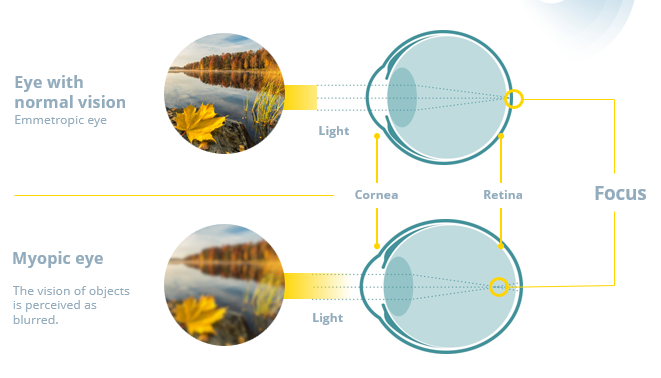INTRODUCTION
Myopia is reaching pandemic proportions around the world, in the United States and Europe, the prevalence of myopia has doubled over the last century and currently affects 40% to 50% of young people (under 35 years of age). East Asia has been especially affected, with around 80% to 90% of urban adolescents, compared to 10% to 20% sixty years ago.
A recent study from the Brien Holden Vision Institute (BHVI) estimates that by 2050, five billion people, equivalent to half the world’s population, will be myopic, and one billion people, or 10%, will suffer from myopia (1).
But what is Myopia?
Myopia is a refractive error that happens when light is focused in from of the retina resulting in a blurred image for large distance objects and a clear image for near distance objects.

Image 1: The myopic visual system
Myopia is classified depending on its magnitude. Extreme myopia is considered when it exceeds the -16.25 diopters. This type of myopia is usually related to visual disabilities affecting both visual acuity and visual field. Extreme myopia can be corrected with glasses, contact lenses, and/or implantation of a lens between the iris and the crystallin.
Uncorrected refractive error has been reported to be the first cause of vision impairment in the world, and under corrected myopia is the most common cause of vision impairment, as judged by presentation for poor visual acuity (2).
Specifically, those users with extreme myopia have very poor visual acuity. The main symptom of extreme myopia is blurred distance vision associated with low visual acuity. If there are other associated pathologies, these may go unnoticed because in their early stages they do not present symptoms (such as glaucoma) or floaters (myodesopsias), flashes, shadows or deformation of straight lines may appear, symptoms which indicate that there is an affectation at the level of the retina.
For all these reasons, it is crucial to provide the best visual solution for those users to achieve the maximum visual acuity and comfort possible.
As extreme myopia users have important visual problems, it will be helpful for them if they can select the desired frame without limitations. This fact will help them psychologically speaking to improve the desired aesthetics as much as possible.
In addition, a lens that considers aesthetics and comfort as a point of interest and basic need for these users will be necessary.
For this reason, there is a commitment between visual quality and visual comfort.
Uncorrected refractive error has been reported to be the first cause of vision impairment in the world, and under corrected myopia is the most common cause of vision impairment, as judged by presentation for poor visual acuity (2).
Specifically, those users with extreme myopia have very poor visual acuity. The main symptom of extreme myopia is blurred distance vision associated with low visual acuity. If there are other associated pathologies, these may go unnoticed because in their early stages they do not present symptoms (such as glaucoma) or floaters (myodesopsias), flashes, shadows or deformation of straight lines may appear, symptoms which indicate that there is an affectation at the level of the retina.
For all these reasons, it is crucial to provide the best visual solution for those users to achieve the maximum visual acuity and comfort possible.
As extreme myopia users have important visual problems, it will be helpful for them if they can select the desired frame without limitations. This fact will help them psychologically speaking to improve the desired aesthetics as much as possible.
In addition, a lens that considers aesthetics and comfort as a point of interest and basic need for these users will be necessary.
For this reason, there is a commitment between visual quality and visual comfort.

Horizons Optical presents extreme PRESCRIPTIONS, a spherical single vision design specifically designed to offer the best optics and aesthetics in extreme myopia corresponding to high sphere ranges.
With extreme PRESCRIPTIONS it optimizes:
- The optics of the lens selects the ideal useful diameter offering maximum sharpness within it.
The ideal useful diameter depends on the prescription and the pupil’s position according to the frame shape.
- The aesthetics of the lens assuring the best optics possible.
- The lightness of the lens. Thanks to the minimum thickness possible, we can get full control of the lens weight.

Image 2: Comparative study of the lens weight considering a prescription of -30D
CONCLUSIONS
Extreme PRESCRIPTIONS have different advantages as it achieves better aesthetics in the final lens, offers a greater range of prescriptions, has optimum optics and it is easy to order.
In conclusion, makes possible the impossible.
REFERENCES
(1)The impact of Myopia and high Myopia. University of New South Wales, Sydney, Australia 16–18 March 2015.
(2)Bourne RR, Stevens GA, White RA, Smith JL, Flaxman SR, Price H et al. Causes of vision loss worldwide, 1990-2010: a systematic analysis. Lancet Global Health. 2013;1:e339–e349.


